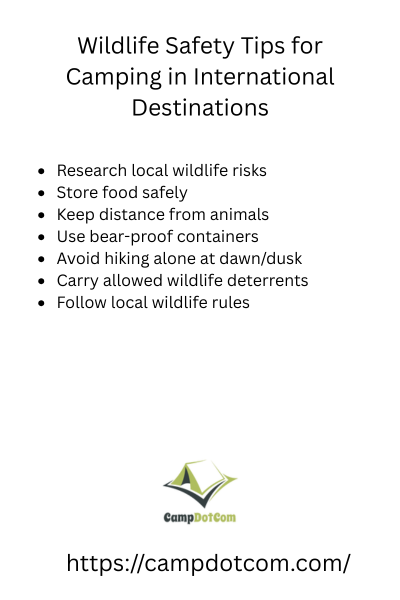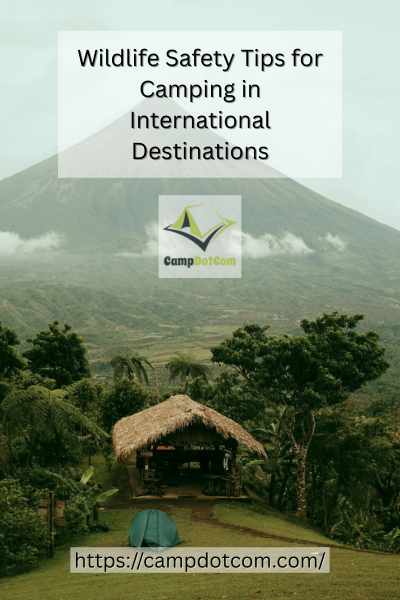If you’re anything like me, the idea of camping in a new country sounds exciting but also a little nerve-wracking—especially when it comes to wildlife. That’s why today, I want to chat about wildlife safety tips for camping in international destinations. Whether you’re dreaming of pitching a tent near African savannahs, South American jungles, or even the wilds of New Zealand, knowing how to stay safe around unfamiliar critters is a must.
Read More About Wildlife Safety Tips for Camping in International Destinations

Why Wildlife Safety Matters (A Personal Story)
I’ll never forget my first international camping trip in Costa Rica. The rainforest was stunning and wildlife was everywhere. It felt like stepping right into a nature documentary. But on my second night, I heard strange rustling outside my tent. I froze, imagining everything from jaguars to giant snakes. Spoiler alert: it was just a coati rummaging through my trash. Still, that moment showed me how unprepared I was for local wildlife encounters.
That experience made me dive into wildlife safety tips for camping in international destinations so I could enjoy my adventures without worry. If you’re planning to camp abroad, let me share some handy advice that will help you sleep peacefully—even if a curious animal comes to visit your camp.
As an Amazon Associate, I earn from qualifying purchases. Some of the links in this article are affiliate links. This means that, at zero cost to you, I will earn an affiliate commission if you click through the link and finalize a purchase.
More Things to Know About Wildlife Safety Tips for Camping in International Destinations

Know Before You Go
Every destination has its own wildlife quirks. What’s normal in one place could be downright dangerous in another. So, the first rule? Research. I mean, really dive into the types of animals you might meet. Are there bears? Poisonous snakes? Aggressive insects? Even local camping forums or travel blogs can give you insights.
When I was planning for Australia, I learned about the notorious spiders and snakes but also about harmless kangaroos that might bounce near campsites. That mix of danger and charm made all the difference in how I packed and planned.
Keep Your Campsite Clean (Seriously)
One mistake I made early on was leaving food scraps and trash lying around. Big no no! Wildlife has a powerful nose, and if you’re inviting raccoons, monkeys, or even bears, you’re just asking for trouble.
Keep your food sealed tight and store it away from your tent. If you can, use bear proof containers or hang bags high up in a tree. It might feel annoying, but trust me, it’s worth it. I once had a cheeky monkey open a cooler right beside my tent because I got lazy about securing it. Lesson learned!
Respect Animal Space
Camping abroad means you’re a guest in someone else’s home, so respect goes both ways. If you spot wildlife, keep your distance. No sudden moves or loud noises. It’s tempting to get that perfect photo or video, but animals can get stressed or defensive.
And no feeding! I know some animals look cute and hungry, but feeding them can mess up their natural behavior and put you in harm’s way. Plus, it’s usually illegal.
Know What to Do If You Encounter Wildlife
This one is a big deal. Different animals need different reactions. For example, if you’re camping in North America and spot a bear, stay calm, avoid eye contact, and slowly back away. But if you’re in Africa and come across a hippo (yes, they can be dangerous!), you definitely don’t want to turn your back.
I always keep a mental checklist of the animals in the area I’m visiting. Honestly, it really helps to have a local guide or experienced camper share tips with you. Sometimes all it takes is a quick heads-up about which animals to watch for and how they behave.
Use Proper Gear and Stay Alert
Wildlife safety is not just about animals; it is about how you prepare. A good tent with sturdy zippers and no holes keeps bugs and smaller critters out. I also swear by a strong flashlight and a whistle. Sometimes just making noise scares animals off.
And here is a little secret: never camp near animal trails or water sources where animals come to drink. It might be tempting for the view, but you do not want to run into unexpected visitors in the middle of the night.
Trust Your Instincts
If something feels off, it probably is. That’s been my go-to safety net on every trip. Sometimes you’ll hear sounds or see tracks that don’t quite add up, and it’s okay to move your camp or change plans. Your gut is often smarter than you think.
Camping abroad should be thrilling but safe, and being cautious doesn’t mean you’re missing out. It just means you get to enjoy nature’s wonders without unwanted surprises.
Your Guide to Safe and Respectful Wildlife Camping Worldwide
So, there you have it, my top tips to keep you safe while you explore wild spots around the world. Remember, the key to wildlife safety tips for camping in international destinations is preparation, respect, and awareness.
Camping internationally opens doors to amazing experiences, but it is also about understanding and honoring the local environment, including its wild residents. Follow these tips and you will be swapping scary animal stories for fun memories instead.
Got any wild camping tales or questions? I am all ears!
Happy and safe camping out there!
